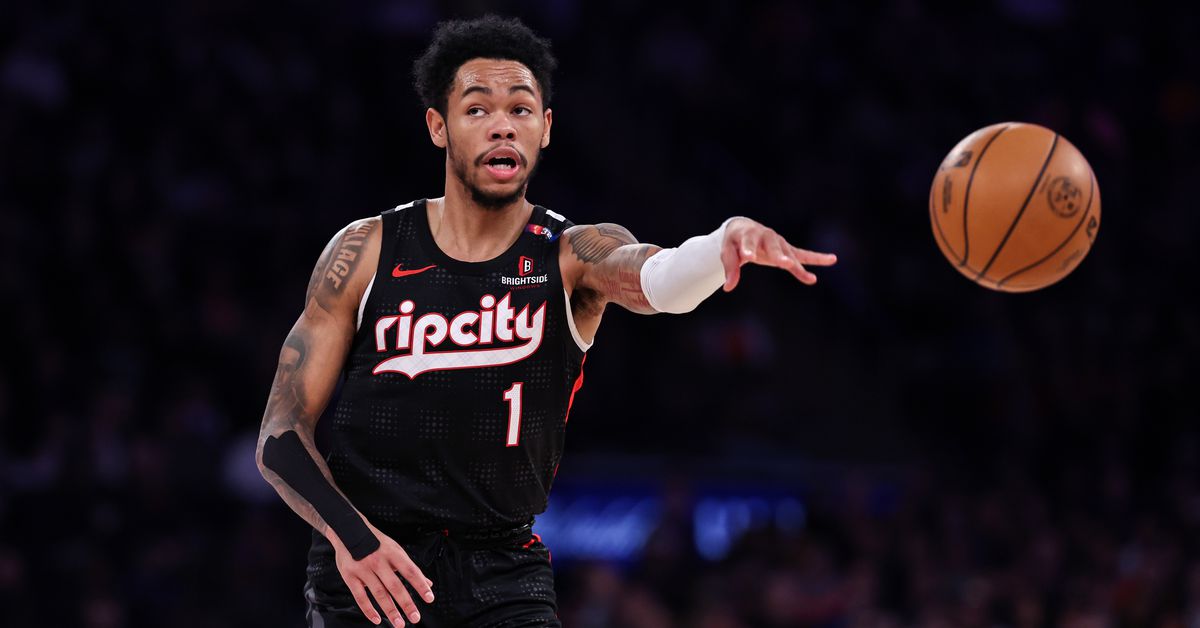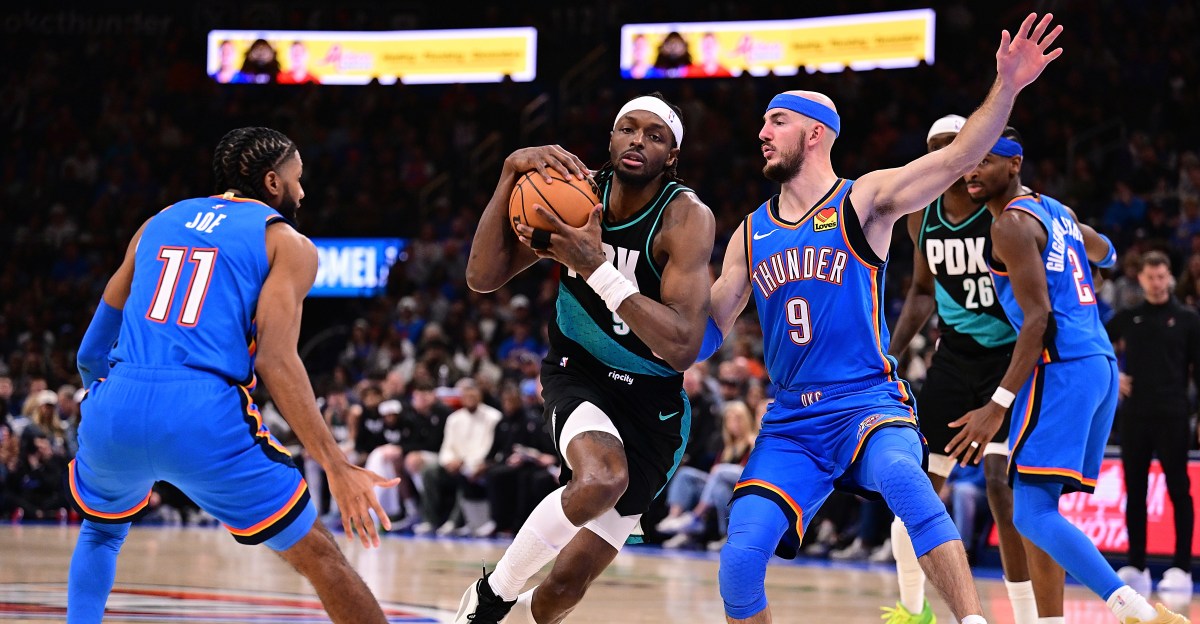How Does the Reported Busy Offseason Impact the Trail Blazers?
The Portland Trail Blazers are approaching a tipping-point transaction window which will dictate the success of their transition from rebuilder to competitive prospect. Their window allowing for cautious and conservative roster building is consequently closing sharply.
General Manager Joe Cronin has been more than passable in his efforts to rebuild in the aftermath of Damian Lillard’s departure, adding young talent and pieces that fit. The fruits of his labor shone particularly during the second half of the 2024-25 season with real development realized by the franchise’s young core.
But with a handful of veterans still on the payroll, Cronin and co need to pick a path. It’s time to forget the inaction that saw only two players (Deni Avdija and Donovan Clingan) added to the roster over the past 12 months and take a swing or two.
Why?
This team has clear deadlines and they’re fast approaching, with veterans Anfernee Simons, Deandre Ayton, Robert Williams III and Matisse Thybulle all entering contract years. If the veterans aren’t moved, they’ll either walk for nothing or be extended, which could compromise the real cap space the franchise could boast 12 months from now.
While the Blazers will always struggle to attract legitimate free agents with cap space, the flexibility said room offers opens up a number of trade possibilities.
Fortunately, this summer’s trade market could be a little more frothy by virtue of relative parity within each conference and an uninspiring 2025 free agent class. Last week, ESPN’s Brian Windhorst reported many within the league predicted it as potentially “explosive”.
Here’s why. The Indiana Pacers are Eastern Conference champions. With Jayson Tatum’s injury, top billing in the righthand conference could realistically be snared by up to six teams. In the Western Conference, the Oklahoma City Thunder are the benchmark but the mantle for close contenders could legitimately be taken by up to eight teams.
Snaring Giannis Antetokounmpo or Kevin Durant could be enough to vault a modest 2024-25 roster into a contender in 2025-26. Let’s not also forget the fact that an NBA team hasn’t won back-to-back Larry O’Brien trophies since the Golden State Warriors in 2018. Dynasties could be a thing of the past, adding more incentive for others to make a play at the title.
But how do the Blazers fit into this potentially volatile summer?
The larger trade chips
Let’s start with the bad news. Jerami Grant is the biggest concern after experiencing a down 2024-25. A year ago, he looked poised to yield the Blazers a haul. With his contract now peeping above $30 million per annum, the number of suitors is, no doubt, diminishing.
But the doom might not be permanent. I might be in the minority but while last season was objectively bad, Grant is still in his prime. There’s nothing stopping him from rediscovering a role as reliable scorer and above-average defender. Trade value shouldn’t dip that severely after one ordinary season when you consider his full body of work.
Contenders will always need two-way forwards with real scoring versatility. And, if he can rekindle that form, the money isn’t that bad when compared to some of the $40-plus million deals being doled out. A return to the Eastern Conference could be the ticket for Grant, particularly the franchise initially desired by Damian Lillard.
The Miami Heat are always looking to make a big swing, but if they strike out, taking a chance on Grant might be an option. Especially if they’re over playing Bam Adebayo at the four. The Blazers probably have to take back a bad contract but in doing so could also snag a protected first.
As for Anfernee Simons, the Orlando Magic have a flawed but talented roster, last season, ranking first in defense but an awful 28th in offense. They need offensive punch, particularly in the backcourt, in order to get them into the upper echelon of the Eastern Conference.
The Orlando-born and raised Simons would slot in perfectly next to Jalen Suggs in the Magic backcourt. Again, with the seemingly-mortal Pacers at the top of the conference, Simons could help lift the Magic from dreadful offense, to passable and into the contention conversation.
Furthermore, depending where the chips fall in prominent deals, Simons would make sense for teams who missed out or need to fill out gutted rosters. He may actually be the Blazers’ most valuable non-rookie-scale trade asset thanks to his pre-prime, proven offensive ability and his sub-$30-million per year deal. One really good or two modest firsts could be had for the combo guard.
In relation to Deandre Ayton, as discussed last week, he makes sense as a member of the Los Angeles Lakers. The Lakers are in dire need of a big man after sending Anthony Davis to the Dallas Mavericks. Ayton’s money isn’t ideal but the Lakers have passable contracts to send back, not to mention that 2031 pick, likely protected.
The Lakers might have put up a bigger fight against the Minnesota Timberwolves who made it all the way to the Western Conference Finals. If there’s anything that’s certain this offseason, it’s that the Lakers will find a starting-level big man. The Blazers would benefit if that big man was Ayton.
Making a big play
It’s unlikely the Blazers become buyers on the market but no one expected the Deni Avdija deal last year. They probably don’t have the means to go after a bigger-than-Avdija-type player but there’s always a chance they help facilitate a deal.
Facilitating bigger deals
This is where Cronin might find the best value. They won’t secure Antetokounmpo but they can definitely profit from a deal involving the big name. Though it now looks unlikely Antetokounmpo leaves, the Blazers own three years’ of Milwaukee Bucks drafts assets later this decade.
If the Greek star does leave Wisconsin, Portland can dangle the picks to bring back an appropriate return. But the Blazers need to be prudent here, the unprotected 2029 Bucks pick could be a real asset and not something you part with for an average return.
As far as taking on more money to help facilitate a larger deal, the Blazers have no cap room and currently sit about $20 million under next year’s luxury tax — so seriously imbalanced trades are not an option. But as mentioned, the Blazers do have collections of veterans on decent contracts (Williams, Thybulle) as well as rookie-scale and veteran-level contracts to offer. Players like Kris Murray, Rayan Rupert, Duop Reath and perhaps even Scoot Henderson (I know this will draw ire) could be inserted to help the Blazers bring back a name of consequence.
The New York Knicks and the Denver Nuggets are two teams in desperate need of depth help. The Blazers could put up a collection of players and picks in return for one player or draft assets that help the franchise moving forward.
Conclusion
The Blazers probably only have four untradeable names in Deni Avdija, Toumani Camara, Shaedon Sharpe and Donovan Clingan. The rest of the roster is made up of veteran, medium and large-sized deals that can be used if the trade market is as busy as predicted.
I’d be supremely disappointed if a couple of veterans weren’t moved this summer. Not only because they don’t fit with what I hope the Blazers are doing but because you don’t want them leaving for nothing 12 months from now.
It’s unlikely the Blazers are buyers but I can very much see them facilitating larger deals in order to ensure this roster is ready to move into the next phase of its development.
This is not hyperbole — the Blazers need to both aggressively and strategically execute the right moves this summer to help them reach their full potential.
Share this content:















Post Comment